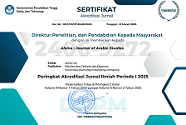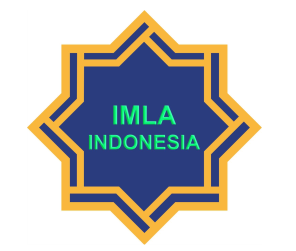Model Kampung Arab Santri Bidik Misi Ma‘had Al-Jami’ah: Adopsi dan Adaptasi Kampung Arab Pare Kediri
DOI:
https://doi.org/10.21580/alsina.2.1.5947Keywords:
kampung arab, ma’had al-jami’ah, adopsi dan adaptifAbstract
This study aims to describe the model and application of the Adopted and adaptive Arab village of the EGYPT Islamic Boarding & Course for English and Arabic village at Pare Kediri to the students of Ya Bismillah Ma'had Al-Jami'ah Putri IAIN Salatiga mission. The method used is interactive qualitative covering three activities: data reduction, data presentation, and concluding. Data was obtained through observation, interview, and documentation. The results of this study indicate that; 1) learning is carried out with the lecture model, Al-Liqa ', al-tamsil and al-munaqosyah. 2) application of management functions that are adopted includes planning, organizing, leadership, and controlling. 3) the supporting factors in the model of the Arabic village, the santri aiming for the mission of Ya Bismillah Ma'had Al-Jami'ah Putri IAIN Salatiga, namely; the methods used by the ustadz and ustadzah, the curriculum, the materials and teaching materials, the ustadz or ustadzah competences and the holding of learning evaluations. The inhibiting factors include: there are limitations to learning Arabic language tools. Besides that, the ustadz / ustadzah has not found the right model for improving Arabic learning in these institutions due to the students' different educational backgrounds.
Downloads
References
Alvi Dyah Rahmawati, Manajemen Pengorganisasian Program Kursus Bahasa Arab di Pare-Kediri, (Journal of Arabic Studies UIN Maulana Malik Ibrahim 2018)
Arief, Armai, Pengantar Ilmu dan Metodologi Pendidikan Islam, (Jakarta: Ciputat Press, 2002)
https://dilokasi.com/Jawa-Timur/Places/Kampung-Inggris--Egypt-Islamic-Boarding-Camp-1184881
http://iainsalatiga.ac.id/web/bidikmisi/
Miles Mathew B. dan A. Michael Huberman, Analisis Data Kualitatif, (Jakarta: Universitas Jakarta. 1992)
Ngalim Purwanto, Psikologi Pendidikan, (Bandung: PT. Remaja Rosdakarya, 2003).
Ratna Sa’idah, Strategi Pembelajaran Bahasa Arab di ITC (Islamic Training Center) Pare, (Journal Realita IAIN Kediri Vol. 14 No. 1 Januari 2016).
Sugiono, Memahami Penelitian Kualitatif: dilengkapi dengan contoh proposal dan laporan penelitian, (Bandung: Alfabeta, 2005).
Tobron, 2001, Metode Penelitian Pendidikan Pendekatan Kuantitatif, Kualitatif, dan R & D, Bandung: Alfabeta.
Wawancara dengan para ustadz/Ustadzah yang terkait dengan penelitian ini pada hari Jum’at, 3 Agustus 2018).
Zainuddin, dkk., 1991, Seluk Beluk Pendidikan Dari Al-Ghazali, Jakarta: Bumi. Aksara.
Downloads
Published
How to Cite
Issue
Section
License
Copyright
The copyright of the received article shall be assigned to the publisher of the journal. The intended copyright includes the right to publish the article in various forms (including reprints). The journal maintains the publishing rights to published articles. Authors are allowed to use their articles for any legal purposes deemed necessary without written permission from the journal, but with an acknowledgment to this journal of initial publication.
Licensing
In order for Alsina: Journal of Arabic Studies to publish and distribute research articles, the editors need publishing rights (transferred from author to publisher). This agreement relates to the transfer/publishing copyright license to Alsina: Journal of Arabic Studies but the authors still have significant rights to use and share their published articles.
Alsina: Journal of Arabic Studies supports the need for writers to share, disseminate and maximize the impact of their research and their rights on any database. As a journal article writer, you have the right to various uses of your articles, including that by the institution or company where you work. Copyright can be used without the need for special permission. Authors who publish articles in the Alsina: Journal of Arabic Studies have broad rights to use their work for teaching and scientific purposes without requesting permission, including:
- Use by the author for lectures, presentations, or conferences, with distribution of copies to participants;
- Distribution to colleagues for research use;
- Use in compilations of the author's subsequent work;
- inclusion in a thesis or dissertation;
- Reuse of sections or excerpts from articles in other works (with full acknowledgment of the final article);
- Preparation of derivative works (other than commercial purposes) (with full acknowledgment of the final article);
- Voluntary posting on open websites operated by authors’ or writers' agencies for scientific purposes
When submitting a manuscript, authors do so on the understanding that if accepted for publication, the copyright for publishing (publishing right) of the article shall be assigned/transferred to Alsina: Journal of Arabic Studies.
Authors whose articles are accepted for publication will receive confirmation via email and sent a Copyright Transfer Agreement.


 Accreditation
Accreditation 
 In Collaboration with
In Collaboration with 

 Visitors
Visitors  Article Template
Article Template





